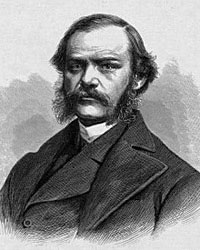Today, I want to introduce you to a man whose impact on journalism shaped the way we receive news. Henry Jarvis Raymond was a journalist, a political leader, a media innovator, and the co-founder of The New York Times. His dedication to reporting and political reform set the foundation for modern journalism.
Raymond was born on January 24, 1820, in Lima, New York. He has always showed a passion for writing and politics. After graduating from the University of Vermont in 1840, he pursued a career in journalism, joining Horace Greeley’s New-York Tribune in 1841 (Smith, 2003). His professional writing and deep political insight quickly gained him recognition.
Raymond didn’t stop at just writing; he was deeply involved in politics as well. By 1848, he became a leading political writer for The Courier and Enquirer, shaping public opinion on key issues of the time. He even stepped into public office, serving as Lieutenant Governor of New York from 1855 to 1856. But his most significant achievement came in 1851, when he co-founded The New York Times with George Jones (Schwarz, 2010).
Now, let’s talk about Raymond’s role at The New York Times. Unlike many newspapers of his era, he believed in fair and balanced reporting. He wanted The Times to be a paper that provided facts. His commitment to honest journalism led The Times to expose corruption, including the infamous Tweed Ring scandal in the 1870s. The Tweed Ring scandal of the 1870s was one of the most infamous cases of political corruption in U.S. history. It was orchestrated by William "Boss" Tweed, the leader of Tammany Hall, a powerful Democratic political machine in New York City. Tweed and his associates, known as the Tweed Ring, controlled city politics and used fraudulent methods to embezzle millions of dollars from taxpayers. They inflated public works contracts, created fake invoices, and took bribes from contractors. The estimated amount stolen was around 200 million (equivalent to billions today). The scandal was exposed by political cartoonist Thomas Nast and investigative journalists, particularly at The New York Times. Public outrage led to Tweed's arrest in 1871, and after several trials, he was convicted and sentenced to prison. He later escaped but was recaptured and died in jail in 1878. While Raymond himself was not involved, his commitment to ethical journalism helped establish The New York Times as a key force in uncovering political corruption.
Raymond also served in Congress from 1865 to 1867 while continuing his work in journalism. Sadly, he died on June 18, 1869, but his influence on the press and politics did not. Today, The New York Times stands as one of the most respected newspapers in the world.




No comments:
Post a Comment